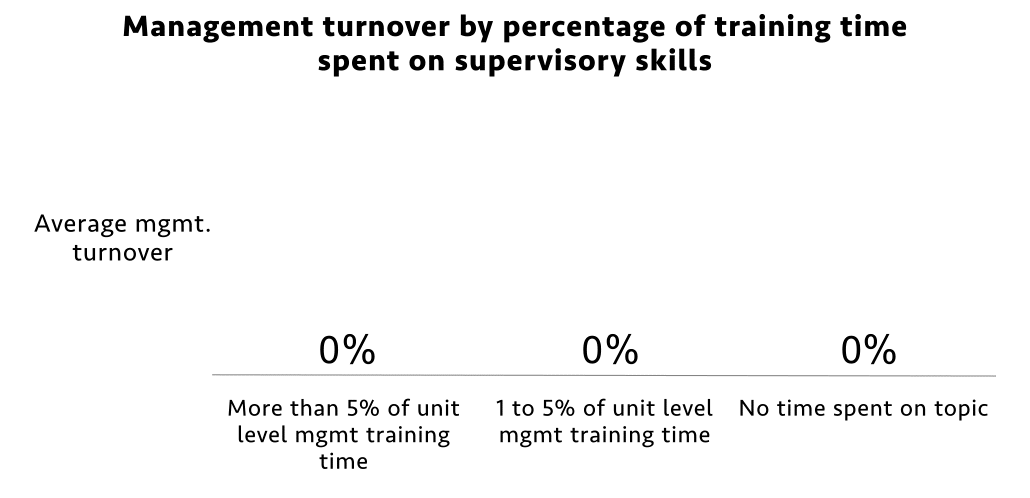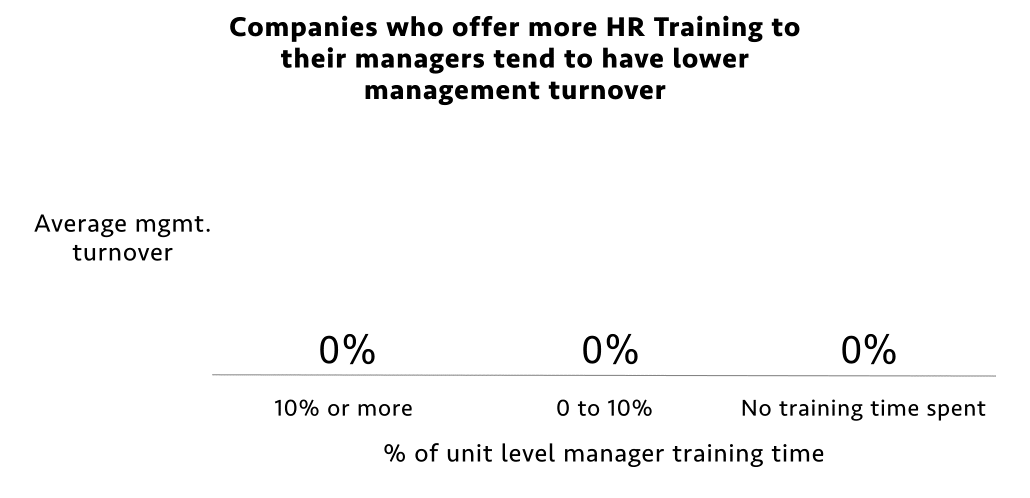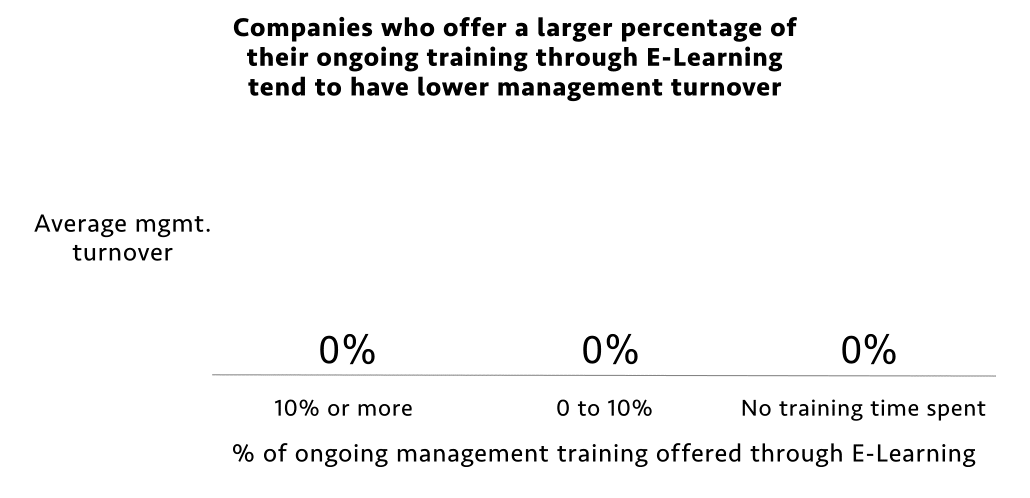
- Home
- Crunchtime Blog
- Why Development Training Reduces Revolving-Door Turnover in Restaurants

Why Development Training Reduces Revolving-Door Turnover in Restaurants
The term “revolving door” is often used to describe turnover in the foodservice industry, with employees seemingly coming and going in an endless cycle. Although unavoidable, restaurant operators know turnover can be costly when not controlled due to the time and monetary costs of hiring, onboarding, and restaurant training. Thankfully, there are several strategies that restaurant operators can introduce into their organizations to help reduce turnover, including management development training.
Below, we dig into the leading causes of management turnover and proven strategies that restaurant operators can use to minimize the loss of talent.
Current Turnover Situation
Management turnover has increased significantly in recent years. According to Black Box Intelligence, the turnover rate for managers in limited-service restaurants rose from 45% at the beginning of 2022 to 70% at the end of the year. Meanwhile, full-service restaurants saw an increase in management turnover from 31% to 45% in that same time period.
And the cost of replacing a manager is exceptionally high, averaging a staggering $14,404 per general manager and $9,148 for other manager types. Improving turnover by even a small amount – say 5% – at a 100-unit chain with five managers per location can save more than $500,000 over the year.
Why Managers Leave
There are, of course, many reasons restaurant managers may choose to leave your organization, but Black Box Intelligence research shows that the top reasons are:
- Higher pay in other industries
- Need for consistent schedules/income
- Lack of professional development opportunities
Interestingly, these top three reasons for employee turnover can be reduced through career advancement opportunities, as promotions often come with higher pay, and, eventually more consistent schedules. It is important to give employees a clear view of their future opportunities because the moment team members start feeling like they have no advancement options, or that the climb will be unnecessarily difficult, then they will look elsewhere for employment.
Many companies have evaluations with a development plan - some do regional restaurant training classes, and some do quarterly goal training. But they often fall short when a manager doesn’t see a clear path to promotion. Unfortunately, a good portion of turnover often comes from your high-potential employees, the people you want to retain. Some of the common threats that can lead a manager to stray include:
- No clear-cut path for advancement
- No program with fair objectives that everyone must complete
- Promotions based on subjective factors or relationships
- Promotions based on seniority verses performance
- No promotion or advancement opportunity within 18-24 months
- Working at a low volume restaurant, where they go unnoticed
These threats can be mitigated with an ongoing management development program that creates a career path for high achievers. By laying out a logical progression from Trainer to Supervisor/Shift Lead, to Manager, to Assistant General Manager, to General Manager, to District/Regional Manager, you can help your best leaders envision their future advancement potential within your organization.
Priorities for Effective Management Development Training
After providing advancement opportunities for qualified candidates, it is important to provide management development training to facilitate positive growth to help managers climb the hierarchy, all while providing high-quality results in the restaurant. Below, we lay out three key ways to make your manager development training strategy more impactful.
1. Prioritize soft skills
Many managers are great at handling the day-to-day tasks of running the restaurant, but when it comes to managing people and other soft skills, they struggle. Those are areas of discomfort for many of them, and when people are uncomfortable, they are more likely to leave. Managing people is not easy, and it is getting more difficult, especially with sensitive issues like harassment and diversity in the spotlight.
Most new managers do not automatically have the soft skills they need to be successful as leaders. If they don’t receive soft skills training from their organization, they either need to develop them on their own or go somewhere they can gain these skills. This skill gap directly impacts another factor that causes managers to leave: work/life balance. Managers who are not competent in skills like coaching, delegation, and leadership take on a more significant burden of completing tasks. By providing specific training aimed at improving these soft skills, you can alleviate a major pain point for your managers.
Research by CHART and Black Box Intelligence proves that investing in training on supervisory skills has a positive impact on management turnover. As shown below, restaurants that spend more than 5% of their training time on supervisory skills have significantly lower management turnover than those that spend little or no time on these topics.

2. Set managers up for store success
Managers who are successful in their roles and run a successful restaurant are more satisfied with their jobs and tend to stay longer. New managers don’t inherently know how to keep tabs on all areas of the restaurant and what steps to take to ensure guest satisfaction. Without training on these essential skills, managers are less likely to be successful and more likely to be at risk of leaving.
When employees are trained thoroughly, starting a job or learning something new, it can help them feel more empowered and confident, meaning that they will perform better and be more likely to stay in their position. Rather than feeling daunted by the tasks at hand and discouraged by constant corrections, they can feel assured that they know what to do. This is especially important when training managers, as the pressure to meet the expectations of both other managers and subordinates can be overwhelming and cause poor performance and dissatisfaction.
Be sure to prepare managers right from the start by offering comprehensive training in the most important areas of their role. Using a restaurant training platform can assist in this process, as it can streamline training while maintaining consistency.
3. Increase HR training

Reports from Black Box Intelligence and CHART show that hospitality companies that spend 10% of their ongoing management training on human resources-related topics tend to have much lower management turnover rates than those that spend little or no time on these topics.
Online Training Makes it Easy
An effective way to ensure that training is cost-effective and thorough is to utilize online systems to curate and administer employee or manager training. Not only can online training be provided during the onboarding process, but also as an ongoing supplement to help refresh knowledge or teach new ideas when necessary. Restaurant training software can help guarantee that employees and managers are consuming the right training materials at the right time while also helping upper management understand training progress.
If you are apprehensive about conducting soft-skills training online, make sure that the courses you select are hospitality-specific and highly interactive, allowing managers to practice their new skills as they learn. According to CHART and Black Box Intelligence, use of e-learning for ongoing training is correlated with better management retention results. As shown below, companies that offer 20% or more of their ongoing management training through e-learning tend to have much lower management turnover rates than those that offer less training via e-learning.

With a few straightforward steps, and the right tools to support, you can stop your valued managers from walking out the (revolving) door. In addition to the potential to save more than $14,000 per manager retained, you will also see happier employees, happier guests, and more successful restaurants overall. Learn more about CrunchTime's talent development solutions.
Share this post
Related


Three Key Ways to Use Your Restaurant’s LMS to Drive Tangible Results


